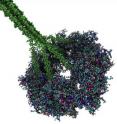Plant protein puzzle solved
Researchers from North Carolina State University believe they have solved a puzzle that has vexed science since plants first appeared on Earth. In a groundbreaking paper published online this week in Proceedings of the National Academy of Sciences, the researchers provide the first three-dimensional model of an enzyme that links a simple sugar, glucose, into long-chain cellulose, the basic building block within plant cell walls that gives plants structure. Cellulose is nature's most abundant renewable biomaterial and an important resource for production of biofuels that represent alternatives to fossil fuels.
New understanding of the structure of the modeled plant enzyme, a cellulose synthase, may allow researchers to genetically engineer plants and trees for better cotton fibers or stronger wood, for example. From a materials engineering perspective, the findings can also be used to create beneficial nanocrystals with desired properties and functions.
"This structural model gives us insight into how cellulose synthesis works," said Dr. Yaroslava Yingling, an NC State materials science and engineering professor who is the corresponding author on the study. "In the long term, it could result in new genetically modified plants that can be tweaked to induce specific engineered properties of cellulose."
The study examined the structure of one cellulose synthase found in cotton fibers. The researchers compared their model with the structure of a similar enzyme in bacteria and found that the proteins were similarly folded in key regions required for cellulose synthesis. In the lab rat of the plant family -- Arabidopsis thaliana, or mustard weed -- the researchers identified potential causes for defective cellulose synthesis in mutant plants by making analogies to the modeled cotton cellulose synthase.
"Without the enzyme structure, you can't make strategically designed, rational projections about how to make beneficial changes to the proteins -- but now you can," said Dr. Candace Haigler, an NC State crop scientist and plant biologist who co-authored the study. "In the future we could make cellulose easier to break down into biofuels while ensuring that the plants themselves are able to grow well."
Latsavongsakda Sethaphong, an NC State doctoral student, co-authored the study, as did researchers from Penn State University, the University of Virginia, the University of Ontario Institute of Technology and the University of Kentucky. The computational research was supported as part of The Center for LignoCellulose Structure and Formation, an Energy Frontier Research Center funded by the U.S. Department of Energy, Office of Science.
Source: North Carolina State University
Other sources
- Plant protein shape puzzle solved by molecular 3-D modelfrom Science DailyMon, 15 Apr 2013, 23:10:12 UTC
- Plant protein shape puzzle solved by molecular 3-D modelfrom PhysorgMon, 15 Apr 2013, 21:30:54 UTC
